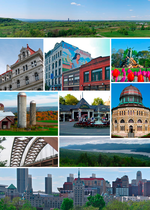Townsend Park
Parks in Albany, New YorkUrban public parks

Townsend Park is a small urban park in Albany, New York. It encompasses a triangle of land formed by the Y-intersection of Central and Washington avenues (north and south borders respectively), with the third (western) border formed by Henry Johnson Boulevard.
Excerpt from the Wikipedia article Townsend Park (License: CC BY-SA 3.0, Authors, Images).Townsend Park
Central Avenue, City of Albany
Geographical coordinates (GPS) Address Nearby Places Show on map
Geographical coordinates (GPS)
| Latitude | Longitude |
|---|---|
| N 42.657769444444 ° | E -73.7648 ° |
Address
10th Ward Memorial
Central Avenue
12304 City of Albany
New York, United States
Open on Google Maps











